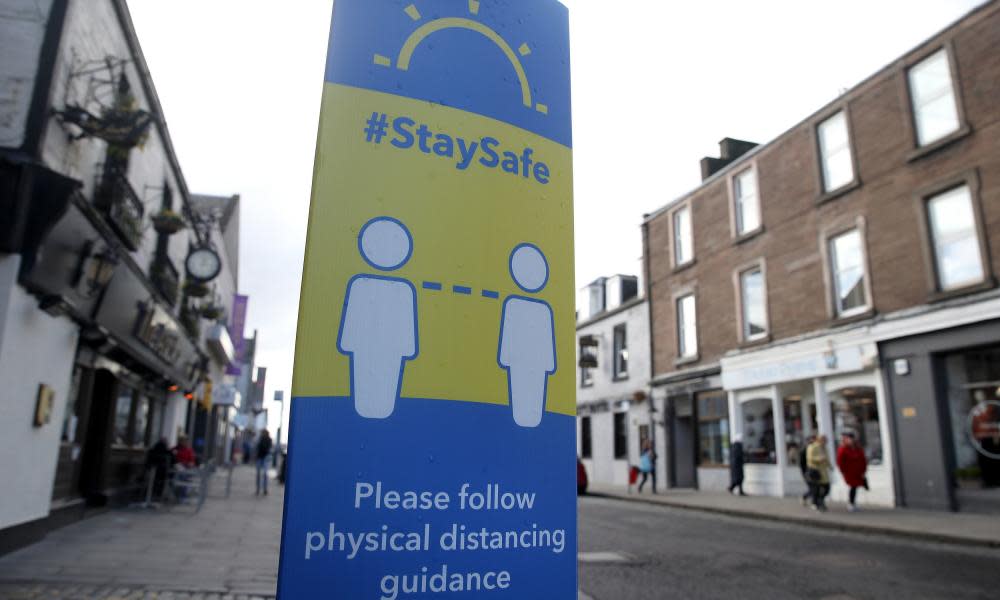Scotland braces for tighter Covid controls under five-level system

Millions of residents across central Scotland face a continued ban on indoor socialising and drinking in pubs and restaurants alongside significantly tighter travel restrictions from Monday, as the Scottish government’s five-level system of Covid controls comes into force.
Councils in four health board areas that have faced some of the toughest restrictions in the UK since 9 October – Greater Glasgow and Clyde, Ayrshire and Arran, Lothian, and Forth Valley – will be placed in level 3, along with Dundee.
Those living in level 3 areas are advised not to travel beyond their local authority area, unless they have to do so for essential reasons including for work, education, healthcare or caring responsibilities. This represents a major reduction in permitted travel for residents, who are currently allowed to move freely within their much larger health board areas.
Appealing to the public to comply with the new travel limits, Sturgeon said: “I know travel restrictions are unwelcome and can be controversial, but they are an absolutely essential part of any regional approach to tackling Covid. They are, unfortunately, a price we must pay for more targeted restrictions.”
default
The council areas assessed as level 3 are Inverclyde, East and West Dunbartonshire, Renfrewshire and East Renfrewshire, and the city of Glasgow; South Ayrshire, East Ayrshire and North Ayrshire; Stirling, Falkirk and Clackmannanshire; the city of Edinburgh, Midlothian, West Lothian and East Lothian.
Despite suggestions that North and South Lanarkshire councils, which have reported high levels of infection and hospital admissions, would be placed under the most severe level 4 restrictions, Sturgeon said it was a “borderline decision” to place them in level 3 after local council, health and police chiefs pleaded with her not to impose the near-lockdown conditions.
Related: Scotland's 5-level system to contain Covid explained
Sturgeon announced the new levels, which will be reviewed weekly, to the Holyrood chamber as she confirmed there were 1,128 new infections and 37 deaths in the past 24 hours, and cautioned that she could not rule out a move back to nationwide restrictions in the next few weeks, including at level 4.
Local authorities placed in level 2 include Aberdeenshire, Aberdeen, Fife, the Borders, Dumfries and Galloway, Argyll and Bute, and Angus.
Perth and Kinross will also be in level 2, after reports that NHS Tayside lobbied Sturgeon to put the area into level 3, the same tier as Dundee, despite the latter’s Covid-19 rate being approximately three times higher. The health board had argued that putting both areas in the same tier would assist virus management.
Highland, Moray, Western Isles, Orkney and Shetland, which have far fewer cases of the virus, have all been assessed as level 1 areas. Sturgeon said she hoped shortly to allow indoor household meetings for that tier, noting that “for our more rural and island communities that restriction can cause particular difficulty”.
No areas will be placed in the highest or lowest tiers.
The first minister told the chamber that early action taken at the start of October had led to “encouraging signs” in terms of slowing the spread of infection, but warned: “We must be under no illusions. Europe is now firmly in the grip of a second wave of Covid.”
Sturgeon told MSPs that the assessment of which tier was right for each local authority was based on five key factors: the number of positive cases per hundred thousand people over the last week; the percentage of positive tests; the forecast for new cases in the weeks ahead; and the capacity of local hospitals and intensive care facilities.

 Yahoo News
Yahoo News 
